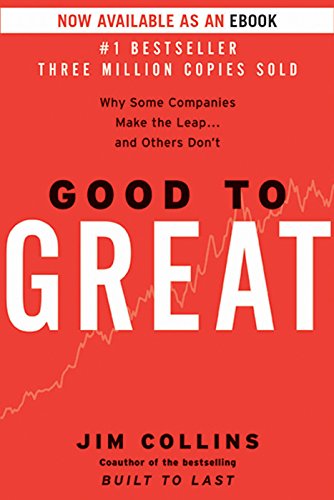

This article is an excerpt from the Shortform summary of "Good to Great" by Jim Collins. Shortform has the world's best summaries of books you should be reading.
Like this article? Sign up for a free trial here .
What is Jim Collins’s “Level 5” leadership concept? Who are “Level 5” leaders? How do you become one?
Level 5 Leadership is the leadership of “good-to-great” companies that are led by “Level 5” leaders. These leaders are personally humble but professionally driven executives, and they make the best leaders of companies.
We’ll cover what Jim Collins’s Level 5 leadership concept is (from Good to Great), who Level five (Level 5) leaders are, and how to become a Level 5 leader.
Jim Collins’s Level 5 Leadership
Top-Line Takeaways
- Good-to-great leaders exhibit Jim Collins’s “Level 5 Leadership” (level five leadership): Personal humility coupled with professional drive. Comparison company leaders, by contrast, were often egotistical, charismatic, and eager to credit themselves and blame others.
- Despite Level 5 leaders’ personal modesty, they do whatever it takes to get results.
- Level 5 leaders groom successors so that their companies stay successful after they depart. The leaders of the comparison companies, however, because they believed themselves to be geniuses or felt threatened by other managers’ rise, devoted no time to educating successors or preparing the company for their inevitable departure.
- Level 5 leaders tend to emerge from within the company, rather than get brought in from the outside.
- Instead of “looking in the mirror” to give credit for their company’s success, good-to-great leaders will “look out the window,” apportioning credit to external factors (e.g., luck) or their colleagues.
What Makes a Level Five Leadership?
If we’re asked to name a successful CEO, we’re liable to think of celebrity executives like Tim Cook and Elon Musk, figures who have a larger-than-life presence and appear frequently in the media.
(Shortform example: We’re less likely to think of someone like Rodney McMullen, current CEO of Kroger. McMullen was raised on a farm in Kentucky, was the first in his family to go to college, and began his career at Kroger as a part-time stock clerk. He has no Twitter feed, and his hobby is collecting books. Yet he runs the largest supermarket chain (by revenue) and the second-largest general retailer in the U.S.)
Through their research, Collins and his team discovered that all of the good-to-great companies had leaders like McMullen: personally humble but intensely driven and disciplined professionals.
Collins and his team dubbed these unique executives “Level 5 Leaders.” Level 5 leaders check their egos at the door and sacrifice personal glory for the institutional good. A Level 5 leader’s primary concern is company success, not his or her own. This is the key to Jim Collins’s “Level 5 Leadership.”
To distinguish Level 5 leadership from more ordinary managers, here are all 5 levels of contributors:
- Level 1: A capable individual contributor. A talented and productive individual with good work habits.
- Level 2: A productive team member. A talented and productive contributor who also makes those around him or her better.
- Level 3: An effective manager: A person who can marshall people and resources to achieve a decided-upon objective
- Level 4: A leader. One who can inspire subordinates and achieve higher performance
- Level 5: A Level 5 Leader. Exceeds expectations through a unique combination of humility and drive; funnels personal ambition into company success.
The Qualities of Level 5 Leadership
Self-Effacing, but Resolute
Jim Collins’s Level 5 Leaders tend to avoid the public eye, have a reserve demeanor, and even tend to shyness. But while not ambitious for themselves, they are ambitious for the company – they never back down from taking responsibility or making a difficult decision.
For example, Darwin E. Smith, CEO of Kimberly-Clark from the 70s through the 90s, was no darling of reporters: He wore unfashionable suits, was uncomfortable in interviews, and preferred the company of manual laborers to that of fellow executives. Rather than take flashy vacations to exotic locales, Smith spent his time off on his property in rural Wisconsin, performing hard labor himself.
Smith’s “aw shucks” demeanor, however, belied a rigorous and gutsy businessman. Shortly after he became CEO in 1971, Smith and his team determined that coated paper, which constituted the core of Kimberley-Clark’s business, featured both little opportunity for growth and poor competition. He made a momentous decision: to sell the company’s paper mills and go all in on consumer paper goods, where growth potential was significant and competition fierce.
The decision was panned by industry analysts, but it paid off: During Smith’s 20-year tenure as CEO, Kimberly-Clark produced cumulative stock returns 4.1x the general market return. Smith exemplified Jim Collins’s “Level 5 Leadership.”
Prepares the Next Generation of Level 5 Leadership
Because Level 5 leaders subsume their egos to a single objective—making their companies successful—they are compelled to groom successors to ensure their companies’ continued success.
David Maxwell, CEO of Fannie Mae in 80s, for example, took over a company losing $1 million a day and transformed it into one earning $4 million a day in profit. Rather than cling to the job, Maxwell retired at the height of his powers in 1990, leaving the company in the able hands of his chosen successor, Jim Johnson.
Maxwell’s “company-first” mentality continued even into his retirement. When his generous retirement package came under fire in the U.S. Congress, Maxwell told Johnson to redirect the amount still to be paid—about $5.5 million—to the Fannie Mae foundation so that it could help low-income Americans secure mortgages. For Maxwell, the company’s reputation was more important than his personal gain.
Comes from Within the Company
Jim Collins’s “Level 5 Leaders” were often promoted to chief executive rather than hired from outside.
Good-to-great executives Darwin Smith (Kimberly-Clark), Colman Mockler (Gillette), and George Cain (Abbott Laboratories) all emerged from within the ranks of their respective companies, whereas comparison CEOs like Al Dunlap (Scott Paper) and Lee Iacocca (Chrysler) were brought in.
Takes Blame and Deflects Credit
In Collins’s interviews, good-to-great CEOs credited their colleagues—or just dumb luck—for their companies’ successes, whereas comparison leaders were quick to blame outside factors or others for their companies’ failures.
Good-to-great leaders will “look out the window” when assigning credit for their successes, whereas lesser leaders will “look in the mirror.” This is an important aspect of Jim Collins’s “Level 5 Leadership.”
A prime example is Joseph F. Cullman, CEO of Philip Morris in the 60s and 70s, who watched Marlboro become the most popular cigarette brand in America. Despite leading the company to returns 7x the general market, Cullman staunchly refused to take credit for the company’s success, instead pointing to predecessors, contemporaries, successors—and luck. In fact, at the request of his admiring colleagues, Cullman wrote a book originally intended for their enjoyment only. The title? I’m a Lucky Guy.
Anti-Level 5 Leadership
The leaders of Collins’s comparison companies, unlike their good-to-great peers, were egotistical or braggadocious; brought in from outside the company hierarchy; reluctant to groom successors; and eager to take credit and deflect blame.
The flaws of the comparison company leaders all stemmed from their egocentrism. They didn’t groom successors because (1) they wanted to be the “lead dog” and (2) if the company failed after they left, it would be a testament to their personal impact. They took credit and deflected blame because, in their minds, they were the smartest people in the room and couldn’t be wrong.
Anti-Level 5 Leadership Example (comparison): Lee Iacocca (Chrysler)
Lured away from Ford to Chrysler in the late 70s, Iacocca deserves credit for leading one of the most impressive turnarounds in business history—he took a company on the brink of bankruptcy to 3x returns on the general market by the midpoint of his tenure.
But shortly thereafter, he began to concentrate more on growing his personal brand than Chrysler: He frequently appeared on talk shows and wrote an autobiography touting his business genius. He even contemplated running for president!
The second half of his tenure reflected his priorities: Chrysler stock fell 31% behind the general market return.
And despite the company’s diminishing performance, Iacocca refused to pass the torch. He postponed his retirement so many times, employees joked that his last name stood for “I Am Chairman of Chrysler Corporation Always.” This ensured a weaker leadership when he inevitably left the company, one way or another.
After he finally left in the early 90s, Chrysler returned briefly to glory, but the gaps in its next generation of leadership quickly became clear. The company eventually had to be bought out by Daimler-Benz.
Can Level 5 Leadership Be Learned?
Collins admits that the traits that epitomize a Level five leader, like humility and ambition for the group, may be difficult to cultivate, as they’re a product of a particular person’s upbringing, life and work experience, and personality.
Also, because his research focused on what it takes for a good company to become a great one—rather than what life experiences result in a Level 5 leader—he lacks the hard data to back up any suggestions he might make.
His best advice, if you suspect that your personal ambition might prevent you from qualifying as a Level 5 leader, is to mimic the actions of Level 5 leadership as described in the remainder of the book. Level 5 leadership and the disciplines covered later are strongly correlated, so it stands to reason that, by adhering to those disciplines, one might achieve Level 5 leadership status (or something approximating it).
———End of Preview———

Like what you just read? Read the rest of the world's best summary of "Good to Great" at Shortform . Learn the book's critical concepts in 20 minutes or less .
Here's what you'll find in our full Good to Great summary :
- The 3 key attributes of Great companies
- Why it's better to focus on your one core strength than get spread thin
- How to build a virtuous cycle, or flywheel effect, in your business






